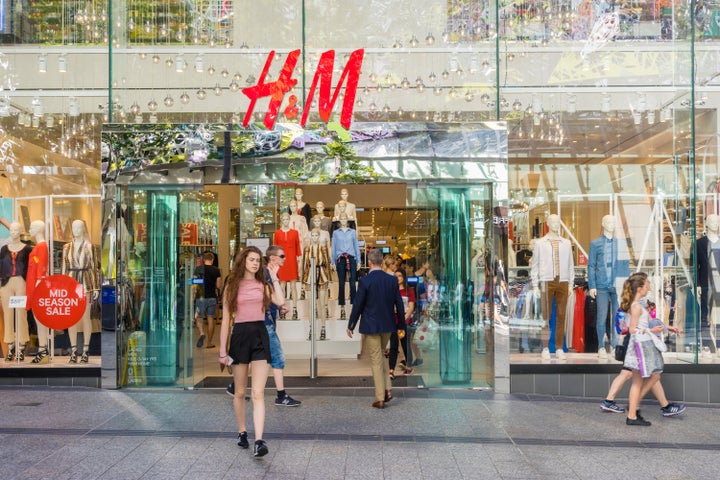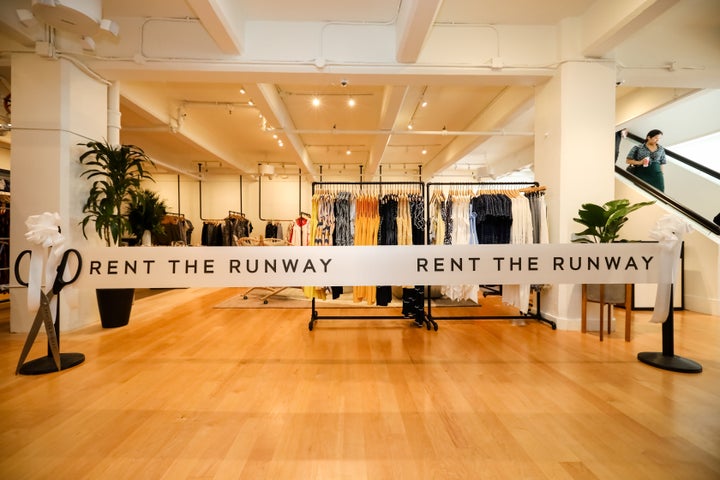“Fashion and quality at the best price, in a sustainable way!” shouts H&M’s Twitter bio. That’s how the Swedish company wants its customers to think of the brand.
The fast-fashion behemoth has gone to great lengths to claim sustainable status in recent years. Its Conscious Collection features garments made from organic cotton, recycled polyester, lyocell and, as of its next collection, Circulose, a textile made from recycled clothes. H&M releases a yearly sustainability report, and an in-store recycling scheme is in place so customers can drop off a bag of their unwanted clothes in return for a 15% discount.
Zara, owned by Inditex –– which, according to some rankings, is the most profitable fashion company in the world ― also makes bold sustainability commitments. It has pledged to make its clothes from 100% sustainable materials by 2025.
Sustainability is the new buzzword for the fashion industry. Over the course of just three or four years, awareness of the environmental impact of fashion has skyrocketed. In its 2019 Year in Fashion report, the global fashion search platform Lyst reported that searches that include sustainability-related keywords have increased 75% year on year, with specific searches for more sustainable materials such as Econyl (a form of nylon made from waste products) and organic cotton (which doesn’t rely on environmentally harmful pesticides or fertilizers) are on the rise, too.
In response to increased scrutiny and consumer interest, brands have reacted quickly, turning to returns schemes and recycled and organic materials to level up their sustainable credentials.

While these brands may appear to operate sustainably on the surface, their underlying goals remain the same: to sell as much as possible to as many people as possible.
In 2019, the H&M Group, which already has 593 stores in the United States alone, opened 281 stores globally — more outlets for the 600 million garments that it reportedly manufactures each year. The H&M Group also counts COS, Weekday, Monki, & Other Stories and ARKET among its brands and, over the course of 2019, expanded the five brands into 70 new markets.
And Zara may have made big commitments on materials, but it still releases 500 new designs each week, adding up to more than 20,000 a year.
“In H&M’s case, having some ‘sustainable’ materials in the mix makes little difference when in 2018 they overproduced $4.3 billion worth of goods.”
- Timo Rissanen, associate professor of fashion design and sustainability at Parsons
Such a huge output puts a strain upon the environment in varying ways. To make just a single T-shirt, for instance, takes 594 gallons of water — as much as one person would drink in two and a half years. The industry as a whole uses 1.3 trillion gallons of water a year for fabric dyeing alone, and it isn’t just using up water; it’s also polluting it.
During the manufacturing process, wastewater, chemicals and dyes are released into local bodies of water, destroying ecosystems, killing aquatic life and contaminating the groundwater. And this pollution continues after clothes are purchased ― as many as 1.5 million microfibers are released when synthetic clothes are washed, contributing to plastic pollution in waterways.
While hard and fast data on the fashion industry is hard to pin down, it’s reported that the sector is also responsible for 8% of global greenhouse gas emissions. Manufacturers pump out more than 100 billion garments per year, and yet so much is wasted — destroyed by brands when it goes unsold and sent to landfills by consumers once they’re finished with it.
“The [fast-fashion] business model is inherently unsustainable,” says Timo Rissanen, author, zero waste designer and associate professor of fashion design and sustainability at Parsons School of Fashion in New York. “The challenge is applying the concept of planetary boundaries to an individual business. If we know there is a finite amount of pie, how do we determine which brand gets how much of the pie? At the moment, most businesses operate as if all of the pie was theirs alone, and even then as if the pie was limitless.”
“In H&M’s case,” Rissanen continues, “having some ‘sustainable’ materials in the mix makes little difference when in 2018 they overproduced $4.3 billion worth of goods.”
A spokeswoman for H&M said sustainability was “embedded” in the company. “Our critics often conflate the size and scale of H&M with our sustainability work when discussing us, but the truth is that these are two separate issues,” she said in a statement to HuffPost. “Our aim is to move to a fully circular business model where resources stay in use and nothing goes to waste, meaning that the scale of our production won’t have the environmental impact it has had in the past.”
HuffPost contacted Inditex for comment but had not heard back at the time of publication.
What does sustainability even mean?
Certainly, growth for growth’s sake and ever-rising sales seem irreconcilable with true sustainability, so perhaps we need to ask exactly how brands are framing sustainability in the first place.
“What are they measuring? What are they thinking of as sustainable?” asks Céline Semaan, founder and CEO of Slow Factory, a design lab that works with companies to research and implement sustainability-focused initiatives.
Semaan says that many brands are thinking about sustainability in terms of their own operations when they should be thinking of it in terms of the environment.
“That’s what the word was supposed to be defining: sustainability for our ecosystems, for our resources, for our human labor. They are part of this large machine that requires them to overproduce and relies on the insecurities of the public that over-purchases,” Semaan said.
To target the real issues ― overproduction and overuse of finite resources ― fashion brands must slow down, says Semaan. But, she adds, “less production means that there will be less funds to support their operation,” and as long as the outcome of slowing down is less profit, they’re unlikely to embrace that particular solution.
Hackwith Design House, a Minnesota-based sustainable fashion brand that manufactures everything in-house, understands the difficulty of balancing scale with a truly sustainable model. “It’s so much more expensive, but we believe it is worth it to be able to oversee our production,” says director of operations Erin Husted. “We could grow much faster if our margins could be bigger, but they can’t be if we want to continue to be sustainable and ethical. We just have to be a lot more patient.”
“What are they measuring? What are they thinking of as sustainable? They are part of this large machine that requires them to overproduce and relies on the insecurities of the public that over-purchases.”
- Céline Semaan, founder and CEO of Slow Factory
The added expense of manufacturing in-house is reflected in Hackwith Design House’s prices, which are 10 times that of something comparable from H&M. Higher prices represent the true value of safer working conditions for garment workers, more sustainable practices in the supply chain and better quality, but they’re still a barrier many brands struggle to move past.
Still, as a smaller brand, Hackwith Design House can keep a careful eye on its scale and production compared to a global conglomerate. Where enormous, continent-spanning brands are concerned, Semaan believes that slowing down will not happen overnight ― or perhaps at all ― so at Slow Factory, she works hard to capture and reintroduce into the supply chain materials that would otherwise go to waste.
“If we aren’t going to convince them to slow down overall, which is the main objective, we can at least slow down and mitigate the amount of waste,” she says. For many brands, it’s a case of retrofitting their operations with sustainable systems including waste recapturing and cleaning wastewater, which is certainly positive for the environment but can still be considered “greenwashing” — a distraction from the real issue.
Even for brands that have been sustainable since day one, scaling up requires a precise plan and framework to ensure that growth doesn’t mean environmental destruction.
Reformation, the cult Los Angeles-based sustainable label, introduced a variety of initiatives to hold itself accountable as it grew, Kathleen Talbot, chief sustainability officer and VP of operations, told HuffPost, from carefully vetting new manufacturing partners to becoming 100% carbon-, water- and waste-neutral, to its Sustainability at Reformation framework.
The goals of the framework include reducing links with mills not certified as sustainable, training on sustainable purchasing practices and building a program to reduce, reuse and recycle fabric scraps.
Reformation also tracks its environmental footprint by adding up the pounds of carbon dioxide it emits, gallons of water it uses, and pounds of waste it generates for every product it makes. It’s a lot of extra work, but staying sustainable as you grow has gotten easier, Talbot believes.
“Honestly, it was lonely when we started 11 years ago,” she said. “Our mill and manufacturing partners thought we were crazy - we were asking a million questions and pushing to our standards, and none of their other clients were doing that. We were told ‘no’ a lot. We still get some of this but see so many opportunities ... The momentum of the industry and willingness to be more sustainable has made it easier for us to scale.”
What is the alternative?
The bigger the scale, though, the more complex the supply chains are and the higher the risk of unwittingly (or, indeed, knowingly) engaging with poorly regulated supplier factories that cause pollution, use child labor and engage in environmentally irresponsible agricultural operations.
Rissanen suggests we turn toward alternative fashion models for which growth isn’t inherent, such as not-for-profit fashion brands like Origin Africa, which puts its profits towards humanitarian causes, employee-owned brands like Eileen Fisher and community-based, nonprofit sharing platforms.
From clothes rental to peer-to-peer sharing platforms such as Tulerie, Wardrobe and Rent the Runway, alternatives are on the rise, with the U.S. apparel rental market set to be worth over $4 billion by 2028. But the issue remains that existing fashion brands need to make far more dramatic changes than the ones they’re currently making.
Consumers and activists can make an impact by buying less and supporting brands that take sustainability seriously, but, experts argue, without industry fully on board, making any real headway will be almost impossible. Voluntary action only goes so far, as H&M and Zara demonstrate. Experts argue that regulation and incentives are what’s needed for genuine business model change.

Governments can step in, just as France did with its ban on the destruction of unsold consumer goods, making it compulsory to hand in the products for reuse or recycling and diverting them from landfills or incinerators. The U.K. introduced the Modern Slavery Act, which has built awareness and increased the identification of potential trafficking victims by 17%, and the state of California introduced its Transparency in Supply Chains Act, which makes retailers and manufacturers provide information on what action they’re taking, if any, to eradicate slavery and human trafficking in their supply chains, plus a recent fur ban that tackles the cruelty and environmental issues associated with the trade.
As for incentives, they must be economic, says Semaan. “We can incentivize good behavior through economic action,” she said. “[Then] it has an economic argument and it has way more chance to be implemented than if it was a philosophical argument.”
Government subsidies can fund sustainable fashion research and development. And taxes could be applied to particularly polluting or resource-heavy garments and fabrics, similar to Canada’s carbon tax, which puts a price on emissions. Or, as the U.K.’s Environmental Audit Committee suggested in its Fixing Fashion report, the tax system could be used to “shift the balance of incentives in favor of reuse, repair and recycling.”
“Existing fashion brands need to make far more dramatic changes than the ones they’re currently making.”
Economic incentives can disrupt the status quo. The U.K.’s 5-pence (7-cent) plastic bag charge, for instance, resulted in a 90% drop in usage, while Sweden, which offers tax reductions for the installation of renewable energy devices, among other incentives, reached its 2020 target of 50% renewable energy production eight years early.
While there is currently little data on the impact of economic incentives for the fashion industry, looking to other sustainable sectors suggests incentives are a path to elevated development and significant systemic change.
Shifts within the fashion industry are happening, but as long as overproduction is the most profitable path, brands, as we’ve seen, are unlikely to hit the brakes and become truly sustainable. Huge system change, not huge growth, is what will lead the fashion industry into a more sustainable future.
HuffPost’s “Work In Progress” series focuses on the impact of business on society and the environment and is funded by Porticus. It is part of the “This New World” series. All content is editorially independent, with no influence or input from Porticus. If you have an idea or tip for the editorial series, send an email to thisnewworld@huffpost.com.

